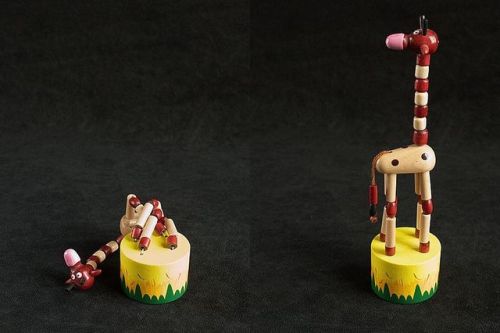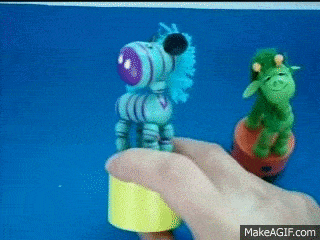
Folds Twist & Lean
With every joint that flexes (and extends), there is an element of rotation attached. Three hundred and sixty moveable joints times multiple degrees of orientation at each makes for an almost unfathomable number of alignment options. Much moreso than correct or incorrect, a more inquisitive approach would be to understand why. What is the relationship between flexion, rotation, and weight shift, and how can one use it to create greater systemic efficiency?
Conceptually, the mechanism of stacking works like a push puppet — getting as fully upright as the parts allow, but adjusting based on lateral leans that lead into rotational biases:

A spring in the base pulls the connected strings of the toy down. When pressed upon, the spring contracts, lessening its length and creating slack in downward pressure. The figure collapses at the loss of supportive tension. The human body attempts to construct a similar arrangement, using gravity (passive) and pushing down (active) respectively.
A master of this concept that I recently found in instagram is @chibatore. Every single movement he posts looks at the directional force vector that rotation manipulates. Opening the front side through the ribs (scapula) and pelvis (hips) utilizes a lack of tension between the pieces. Like the puppet, relaxing into position is a much more steadfast approach than forcing (as long as the parts can rotationally organize).
A pattern that stood out visually and could be re-created sensationally was how internal rotation coupled with flexion and external rotation assisted in extension:
Franco Phang brilliantly commented:
“A picture has come to my mind where rotation of the joints, specifically, create decompression (like screwing), and therefore invites certain movements. Would be interesting to test, from an anatomical point of view which movements (in terms of planes, rotations, flexions, extensions) creates how much of what in which angles. To explore the limits between two words: compensation and invitation.”
Internal rotation ‘screws in and locks down’ while external rotation ‘loosens and lengthens’.
Rotation opens or closes, assists or resists. Note the directional restrictions and freedoms in the single limb examination below. I have many more options to transmit force through (and manipulate position of) the core when I can rotate externally and utilize the lats.
Elbow bent — a flexed joint fixed — rotation gets tied up in the forearm and cannot travel through the rest of the body. I get a stronger ‘whole body’ connection through the bent lever arm but have significantly fewer options in which to move. (A related, more recognizable phenomenon can also be found through hanging rotations.)
Sliding parts stagger instead of stack based on rotational inclinations. Parts shift forward through internal rotation and back through external rotation, in both pushes and pulls:
And this is only through the frontal plane. Can you imagine how things can also offset through the transverse and sagittal planes? One hip or scapula is hiked higher than the other. A knee or foot caves in to provide more support through the midline.
To Review:
INTERNAL ROTATION
*shortens
*screws in
*pushes forward or pulls down
EXTERNAL ROTATION
*lengthens
*loosens
*pulls back or pushes up
Reverting back to the toy and applying it to ourselves, the standing posture is the easiest point of study. Where do you feel the pressure? What might more weight residing on one leg mean? More toes/ ball of feet or heels? Outside of foot or medial inside? [Front and inner translates to IR for stability, back and outer, ER.]
What does a consistent bend in the knees suggest? Though what you might feel is familiar, is it objectively balanced? If you do try to equalize things, does the body feel lighter, and/or the exercise feel easier? Has the position of the pelvis, ribs, and head adjusted to better support positional alignment at rest?
Finally, the act of pushing down is fully responsible for correcting rotational deviations back to a stabilizing baseline. The giraffe would never stand without the strings pulling it uniformly into one piece, no matter how steadfast your stacking of its individual pieces might be. Similarly, the screw won’t move unless you can press into it while making the desired twists and turns. The same can be said for parts in contact with the ground — a weight shift requires a loaded awareness — which cannot happen without purposeful pressure.



